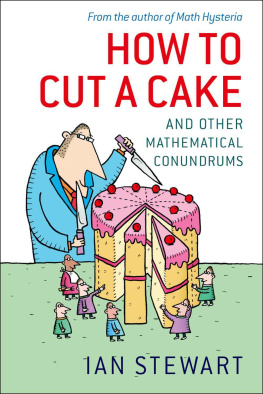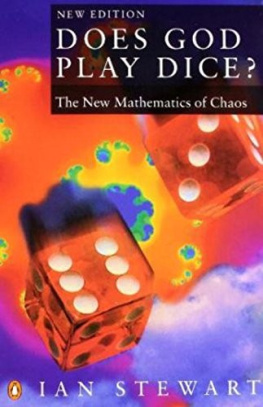PROFESSOR STEWARTS INCREDIBLE NUMBERS
Professor Ian Stewart is known throughout the world for making mathematics popular. He received the Royal Societys Faraday Medal for furthering the public understanding of science in 1995, the IMA Gold Medal in 2000, the AAAS Public Understanding of Science and Technology Award in 2001 and the LMS/IMA Zeeman Medal in 2008. He was elected a Fellow of the Royal Society in 2001. He is Emeritus Professor of Mathematics at the University of Warwick, where he divides his time between research into nonlinear dynamics and furthering public awareness of mathematics. His many popular science books include (with Terry Pratchett and Jack Cohen) The Science of Discworld I to IV, The Mathematics of Life, 17 Equations that Changed the World and The Great Mathematical Problems. His app, Professor Stewarts Incredible Numbers, was published jointly by Profile and Touch Press in March 2014. It was selected as a Best App of 2014 in the US and Canadian app stores and won the DigitalBookWorld award for adult nonfiction.
By the same author
iPad app
Incredible Numbers
Concepts of Modern Mathematics
Game, Set, and Math
Does God Play Dice?
Another Fine Math Youve Got Me Into
Fearful Symmetry
Natures Numbers
From Here to Infinity
The Magical Maze
Lifes Other Secret
Flatterland
What Shape is a Snowflake?
The Annotated Flatland Math Hysteria
The Mayor of Uglyvilles Dilemma
How to Cut a Cake
Letters to a Young Mathematician
Taming the Infinite (Alternative Title: The Story Of Mathematics)
Why Beauty is Truth
Cows in the Maze
Mathematics of Life
Professor Stewarts Cabinet of Mathematical Curiosities
Professor Stewarts Hoard of Mathematical Treasures
Seventeen Equations that Changed the World (Alternative Title: In Pursuit of the Unknown)
The Great Mathematical Problems (Alternative Title: Visions of Infinity)
Symmetry: A Very Short Introduction
Jack of All Trades (Science Fiction eBook)
Professor Stewarts Casebook of Mathematical Mysteries
With Jack Cohen
The Collapse Of Chaos
Evolving the Alien (Alternative Title: What Does A Martian Look Like?)
Figments of Reality
Wheelers (Science Fiction)
Heaven (Science Fiction)
The Science Of Discworld Series (With Terry Pratchett And Jack Cohen)
The Science of Discworld
The Science of Discworld II: The Globe
The Science of Discworld III: Darwins Watch
The Science of Discworld IV: Judgement Day
PROFESSOR STEWARTS INCREDIBLE NUMBERS
IAN STEWART

First published in Great Britain in 2015 by
PROFILE BOOKS LTD
3 Holford Yard
Bevin Way
London
WC1X 9HD
www.profilebooks.com
Copyright Joat Enterprises, 2015
The moral right of the author has been asserted.
All rights reserved. Without limiting the rights under copyright reserved above, no part of this publication may be reproduced, stored or introduced into a retrieval system, or transmitted, in any form or by any means (electronic, mechanical, photocopying, recording or otherwise), without the prior written permission of both the copyright owner and the publisher of this book.
A CIP catalogue record for this book is available from the British Library.
eISBN 978 1 78283 1587
Contents
Preface
I ve always been fascinated by numbers. My mother taught me to read and to count, long before I first went to school. Apparently, when I did, I came back at the end of day one complaining that we didnt learn anything!. I suspect that my parents had been preparing me for this difficult day by telling me that I would learn all sorts of interesting things, and Id taken the propaganda a little too much to heart. But soon I was learning about planets and dinosaurs and how to make a plaster animal. And more about numbers.
Im still enchanted by numbers, and still learning more about them. Now, Im always quick to point out that mathematics is about many different ideas, not just numbers; for example, its also about shapes, patterns, and probabilitiesbut numbers underpin the entire subject. And every number is a unique individual. A few special numbers stand out above the rest and seem to play a central role in many different areas of mathematics. The most familiar of these is (pi), which we first encounter in connection with circles, but it has a remarkable tendency to pop up in problems that seem not to involve circles at all.
Most numbers cannot aspire to such heights of importance, but you can usually find some unusual feature of even the humblest number. In The Hitchhikers Guide to the Galaxy, the number 42 was the answer to the great question of life, the universe, and everything. Douglas Adams said he chose that number because a quick survey of his friends suggested it was totally boring. Actually, its not, as the final chapter demonstrates.
The book is organised in terms of the numbers themselves, although not always in numerical order. As well as . Clearly a lot of potential chapters never made it off the number line. Each chapter starts with a short summary of the main topics to be included. Dont worry if the summary occasionally seems cryptic, or if it makes flat statements unsupported by any evidence: all will be revealed as you read on.
The structure is straightforward: each chapter focuses on an interesting number and explains why its interesting. For instance, 2 is interesting because the odd/even distinction shows up all over mathematics and science; 43,252,003,274,489,856,000 is interesting because its the number of ways to rearrange a Rubik cube.
Since 42 is included, it must be interesting. Well, a bit, anyway.
At this point I must mention Arlo Guthries Alices Restaurant Massacree, a musical shaggy dog story that relates in great and repetitious detail events involving the dumping of garbage. Ten minutes into the song, Guthrie stops and says: But thats not what I came here to talk to you about. Eventually you find out that actually it is what he came to talk about, but that garbage is only part of a greater story. Time for my Arlo Guthrie moment: this isnt really a book about numbers.
The numbers are the entry point, a route through which we can dive into the amazing mathematics associated with them. Every number is special. When you come to appreciate them as individuals, theyre like old friends. Each has its own story to tell. Often that story leads to lots of other numbers, but what really matters is the mathematics that links them. The numbers are the characters in a drama, and the most important thing is the drama itself. But you cant have a drama without characters.
To avoid getting too disorganised, Ive divided the book into sections according to the kind of number: small whole numbers, fractions, real numbers, complex numbers, infinity With a few unavoidable exceptions, the material is developed in logical order, so that earlier chapters lay the groundwork for later ones, even when the topic changes completely. This requirement influences how the numbers are arranged, and it requires a few compromises. The most significant involves complex numbers. They appear very early, because I need them to discuss some features of more familiar numbers. Similarly, an advanced topic occasionally crops up somewhere because thats the only sensible place to mention it. If you meet one of these passages and find it hard going, skip it and move on. You can come back to it later.
Next page
















